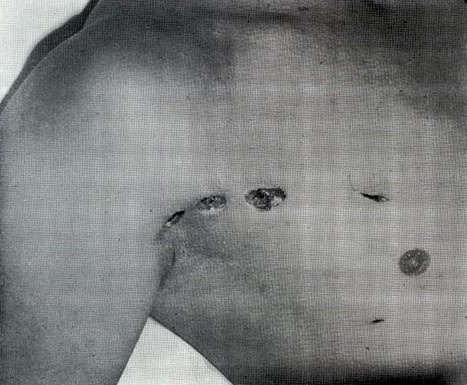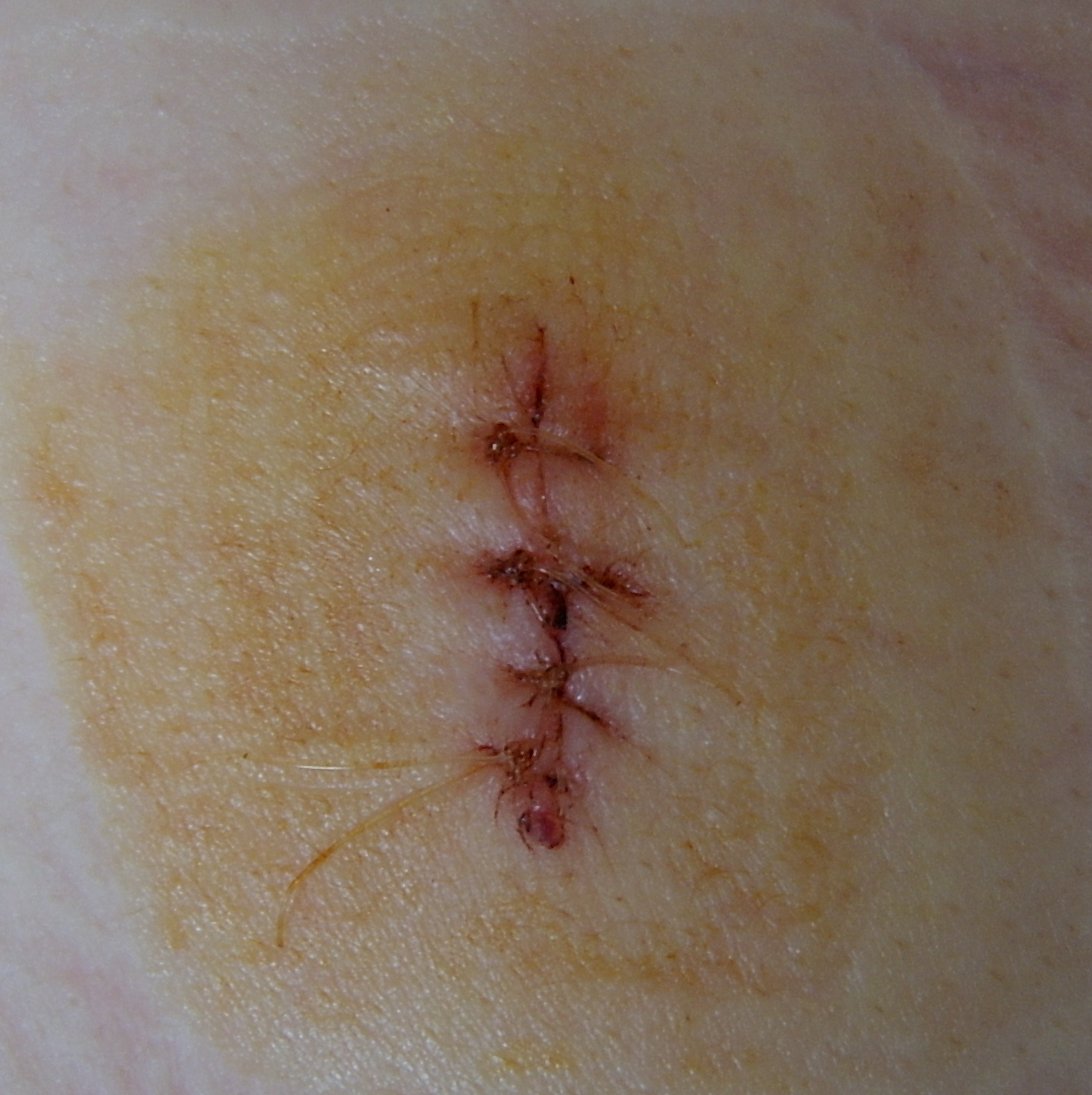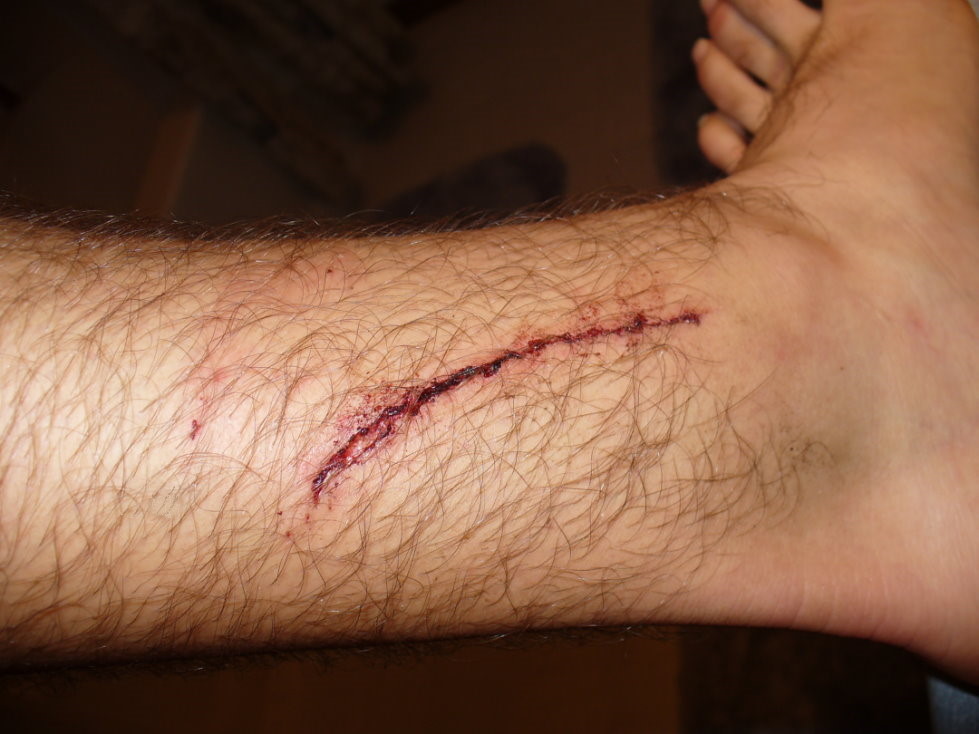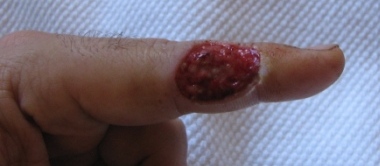Wound
|
WikiDoc Resources for Wound |
|
Articles |
|---|
|
Media |
|
Evidence Based Medicine |
|
Clinical Trials |
|
Ongoing Trials on Wound at Clinical Trials.gov Clinical Trials on Wound at Google
|
|
Guidelines / Policies / Govt |
|
US National Guidelines Clearinghouse on Wound
|
|
Books |
|
News |
|
Commentary |
|
Definitions |
|
Patient Resources / Community |
|
Directions to Hospitals Treating Wound Risk calculators and risk factors for Wound
|
|
Healthcare Provider Resources |
|
Continuing Medical Education (CME) |
|
International |
|
|
|
Business |
|
Experimental / Informatics |
Editor-In-Chief: C. Michael Gibson, M.S., M.D. [1]
Overview
In medicine, a wound is a type of physical trauma where in the skin is torn, cut or punctured (an open wound), or where blunt force trauma causes a contusion (a closed wound). In pathology, it specifically refers to a sharp injury which damages the dermis of the skin.
Classification
Before any medical or paramedical evaluation, a wound is considered as minor when:
- It is superficial (a "flesh wound");
- It is away from natural orifices;
- There is only minor bleeding;
- It was not caused by a tool or an animal.
Any other wound should be considered as severe. If there is any doubt, a wound should be considered as severe. "Severe" does not necessarily mean that it endangers life, but it must at least be seen by a physician. In the case of severe open wounds, there is a risk of blood loss (which could lead to shock), and an increased chance of infection due to bacteria entering a wound that is exposed to air. Due to the risk of infection, wounds should be kept clean, and closed if possible until professional help is available.
Depending on their severity, closed wounds can be just as dangerous as open wounds. An injury to the brain such as a contusion is an extremely dire closed wound, and requires emergency medical attention.
Types of Wounds
Open wounds
Open wounds can be classified into a number of different types, according to the object that caused the wound. The types of open wound are: [1] [2]
- Incisions or incised wounds - caused by a clean, sharp-edged object such as a knife, a razor or a glass splinter. Incisions which involve only the epidermis are legally classified as cuts, rather than wounds.
- Lacerations - Irregular wounds caused by a blunt impact to soft tissue which lies over hard tissue (e.g. laceration of the skin covering the skull) or tearing of skin and other tissues such as caused by childbirth. Lacerations may show bridging, as connective tissue or blood vessels are flattened against the underlying hard surface. Commonly misused in reference to injury with sharp objects, which would not display bridging (connective tissue and blood vessels are severed).
- Abrasions (grazes) - a superficial wound in which the topmost layer of the skin (the epidermis) is scraped off. Often caused by a sliding fall onto a rough surface.
- Puncture wounds - caused by an object puncturing the skin, such as a nail or needle.
- Penetration wounds - caused by an object such as a knife entering the body.
- Gunshot wounds - caused by a bullet or similar projectile driving into or through the body. There may be two wounds, one at the site of entry and one at the site of exit.
In a medical context, all stab wounds and gunshot wounds are considered major wounds.
Closed wounds
Closed wounds have fewer categories, but are just as dangerous as open wounds. The types of closed wounds are:
- Contusions - (more commonly known as a bruise) - caused by blunt force trauma that damages tissue under the skin.
- Hematoma - (also called a blood tumor) - caused by damage to a blood vessel that in turn causes blood to collect under the skin.
- Crushing Injuries - caused by a great or extreme amount of force applied over a long period of time.
Healing
To heal a wound, the body undertakes a series of actions collectively known as the wound healing process.
Infection
Bacterial infection of wound can impede the healing process and lead to life threatening complications. Scientists at Sheffield University have identified a way of using light to rapidly detect the presence of bacteria. They are developing a portable kit in which specially designed molecules emit a light signal when bound to bacteria. Current laboratory-based detection of bacteria can take hours or even days.[3]
Antimicrobial Regimen
- Wound infection[4]
- 1. Mild to moderate
- Preferred regimen (1): TMP-SMX-DS double strength 1-2 tabs PO bid
- Preferred regimen (2): Clindamycin 300-450 mg PO tid
- Alternative regimen (1): Minocycline 100 mg PO bid
- Alternative regimen (2): Linezolid 600 mg PO bid
- 2. Febrile with sepsis
- Preferred regimen (1): Ticarcillin-clavulanate 3.1 gm IV q4-6h (OR Piperacillin-Tazobactam 3.375 gm q6h) AND Vancomycin 1gm IV q12h
- Preferred regimen (2): Doripenem 500 mg IV q 8hr (OR Imipenem OR Meropenem OR Ertapenem 1gm IV q24h) AND Vancomycin 1gm IV q12h
- Alternative regimen (1): Vancomycin 1 gm IV q12h (OR Daptomycin 6 mg/kg IV q24h) AND Ciprofloxacin 750 mg IV q24h (OR Levofloxacin 750 mg IV q24h)
- Alternative regimen (2): Ceftaroline 600 mg IV q12h AND Ciprofloxacin 750 mg IV q24h (OR Levofloxacin 750 mg IV q24h)
- Alternative regimen (3): Telavancin 10 mg/kg IV q24h AND Ciprofloxacin 750 mg IV q24h (OR Levofloxacin 750 mg IV q24h)
References
- ↑ Sailer, Christian, Wasner, Susanne. Differential Diagnosis Pocket. Hermosa Beach, CA: Borm Bruckmeir Publishing LLC, 2002:77 ISBN 1591032016
- ↑ Kahan, Scott, Smith, Ellen G. In A Page: Signs and Symptoms. Malden, Massachusetts: Blackwell Publishing, 2004:68 ISBN 140510368X
- ↑ "Light to detect wound infection" (web). UK scientists have identified a way of using light to rapidly detect the presence of bacteria. BBC News. 11 March 2007. Retrieved 2008-03-17.
- ↑ Gilbert, David (2015). The Sanford guide to antimicrobial therapy. Sperryville, Va: Antimicrobial Therapy. ISBN 978-1930808843.



